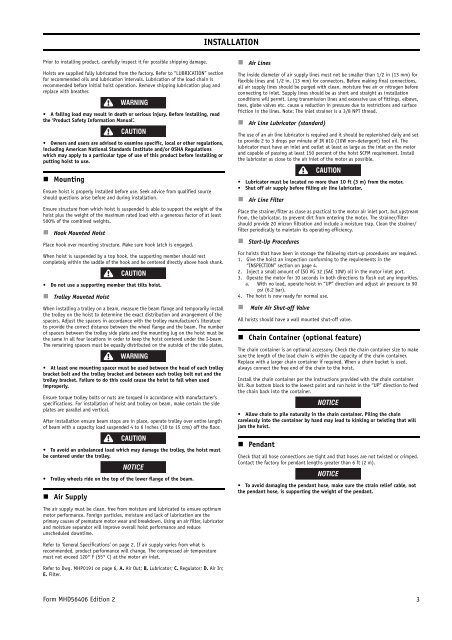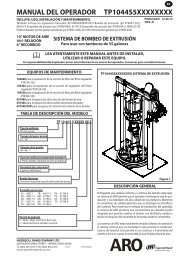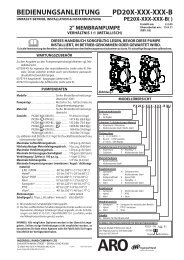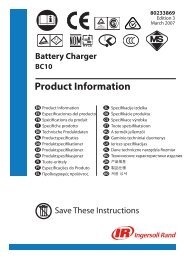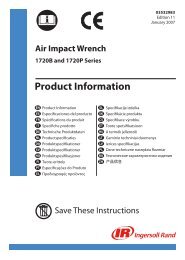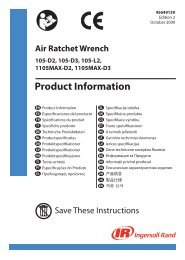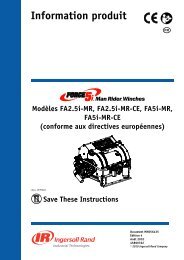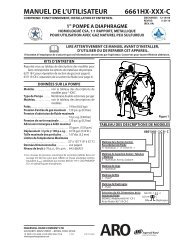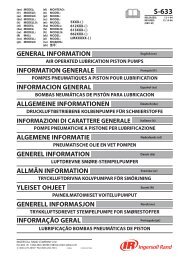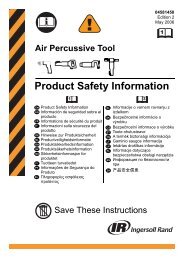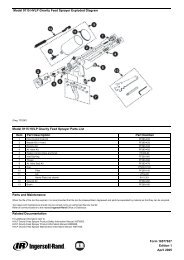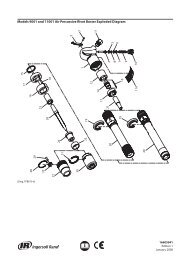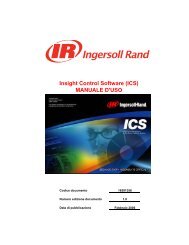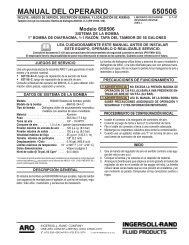Product Information - Ingersoll Rand Industrial Technologies On-line ...
Product Information - Ingersoll Rand Industrial Technologies On-line ...
Product Information - Ingersoll Rand Industrial Technologies On-line ...
You also want an ePaper? Increase the reach of your titles
YUMPU automatically turns print PDFs into web optimized ePapers that Google loves.
Prior to installing product, carefully inspect it for possible shipping damage.<br />
Hoists are supplied fully lubricated from the factory. Refer to “LUBRICATION” section<br />
for recommended oils and lubrication intervals. Lubrication of the load chain is<br />
recommended before initial hoist operation. Remove shipping lubrication plug and<br />
replace with breather.<br />
WARNING<br />
• A falling load may result in death or serious injury. Before installing, read<br />
the ‘<strong>Product</strong> Safety <strong>Information</strong> Manual’.<br />
CAUTION<br />
• Owners and users are advised to examine specific, local or other regulations,<br />
including American National Standards Institute and/or OSHA Regulations<br />
which may apply to a particular type of use of this product before installing or<br />
putting hoist to use.<br />
Mounting<br />
Ensure hoist is properly installed before use. Seek advice from qualified source<br />
should questions arise before and during installation.<br />
Ensure structure from which hoist is suspended is able to support the weight of the<br />
hoist plus the weight of the maximum rated load with a generous factor of at least<br />
500% of the combined weights.<br />
Hook Mounted Hoist<br />
Place hook over mounting structure. Make sure hook latch is engaged.<br />
When hoist is suspended by a top hook, the supporting member should rest<br />
completely within the saddle of the hook and be centered directly above hook shank.<br />
CAUTION<br />
• Do not use a supporting member that tilts hoist.<br />
Trolley Mounted Hoist<br />
When installing a trolley on a beam, measure the beam flange and temporarily install<br />
the trolley on the hoist to determine the exact distribution and arrangement of the<br />
spacers. Adjust the spacers in accordance with the trolley manufacturer’s literature<br />
to provide the correct distance between the wheel flange and the beam. The number<br />
of spacers between the trolley side plate and the mounting lug on the hoist must be<br />
the same in all four locations in order to keep the hoist centered under the I-beam.<br />
The remaining spacers must be equally distributed on the outside of the side plates.<br />
WARNING<br />
• At least one mounting spacer must be used between the head of each trolley<br />
bracket bolt and the trolley bracket and between each trolley bolt nut and the<br />
trolley bracket. Failure to do this could cause the hoist to fall when used<br />
improperly.<br />
Ensure torque trolley bolts or nuts are torqued in accordance with manufacturer’s<br />
specifications. For installation of hoist and trolley on beam, make certain the side<br />
plates are parallel and vertical.<br />
After installation ensure beam stops are in place, operate trolley over entire length<br />
of beam with a capacity load suspended 4 to 6 inches (10 to 15 cms) off the floor.<br />
CAUTION<br />
• To avoid an unbalanced load which may damage the trolley, the hoist must<br />
be centered under the trolley.<br />
NOTICE<br />
• Trolley wheels ride on the top of the lower flange of the beam.<br />
Air Supply<br />
The air supply must be clean, free from moisture and lubricated to ensure optimum<br />
motor performance. Foreign particles, moisture and lack of lubrication are the<br />
primary causes of premature motor wear and breakdown. Using an air filter, lubricator<br />
and moisture separator will improve overall hoist performance and reduce<br />
unscheduled downtime.<br />
Refer to ‘General Specifications’ on page 2. If air supply varies from what is<br />
recommended, product performance will change. The compressed air temperature<br />
must not exceed 120° F (55° C) at the motor air inlet.<br />
Refer to Dwg. MHP0191 on page 6, A. Air Out; B. Lubricator; C. Regulator; D. Air In;<br />
E. Filter.<br />
INSTALLATION<br />
Air Lines<br />
The inside diameter of air supply <strong>line</strong>s must not be smaller than 1/2 in (13 mm) for<br />
flexible <strong>line</strong>s and 1/2 in. (13 mm) for connectors. Before making final connections,<br />
all air supply <strong>line</strong>s should be purged with clean, moisture free air or nitrogen before<br />
connecting to inlet. Supply <strong>line</strong>s should be as short and straight as installation<br />
conditions will permit. Long transmission <strong>line</strong>s and excessive use of fittings, elbows,<br />
tees, globe valves etc. cause a reduction in pressure due to restrictions and surface<br />
friction in the <strong>line</strong>s. Note: The inlet strainer is a 3/8 NPT thread.<br />
Air Line Lubricator (standard)<br />
The use of an air <strong>line</strong> lubricator is required and it should be replenished daily and set<br />
to provide 2 to 3 drops per minute of IR #10 (10W non-detergent) tool oil. The<br />
lubricator must have an inlet and outlet at least as large as the inlet on the motor<br />
and capable of passing at least 150 percent of the hoist SCFM requirement. Install<br />
the lubricator as close to the air inlet of the motor as possible.<br />
CAUTION<br />
• Lubricator must be located no more than 10 ft (3 m) from the motor.<br />
• Shut off air supply before filling air <strong>line</strong> lubricator.<br />
Air Line Filter<br />
Place the strainer/filter as close as practical to the motor air inlet port, but upstream<br />
from, the lubricator, to prevent dirt from entering the motor. The strainer/filter<br />
should provide 20 micron filtration and include a moisture trap. Clean the strainer/<br />
filter periodically to maintain its operating efficiency.<br />
Start-Up Procedures<br />
For hoists that have been in storage the following start-up procedures are required.<br />
1. Give the hoist an inspection conforming to the requirements in the<br />
“INSPECTION” section on page 4.<br />
2. Inject a small amount of ISO VG 32 (SAE 10W) oil in the motor inlet port.<br />
3. Operate the motor for 10 seconds in both directions to flush out any impurities.<br />
a. With no load, operate hoist in “UP” direction and adjust air pressure to 90<br />
psi (6.2 bar).<br />
4. The hoist is now ready for normal use.<br />
Main Air Shut-off Valve<br />
All hoists should have a wall mounted shut-off valve.<br />
Chain Container (optional feature)<br />
The chain container is an optional accessory. Check the chain container size to make<br />
sure the length of the load chain is within the capacity of the chain container.<br />
Replace with a larger chain container if required. When a chain bucket is used,<br />
always connect the free end of the chain to the hoist.<br />
Install the chain container per the instructions provided with the chain container<br />
kit. Run bottom block to the lowest point and run hoist in the “UP” direction to feed<br />
the chain back into the container.<br />
NOTICE<br />
• Allow chain to pile naturally in the chain container. Piling the chain<br />
carelessly into the container by hand may lead to kinking or twisting that will<br />
jam the hoist.<br />
Pendant<br />
Check that all hose connections are tight and that hoses are not twisted or crimped.<br />
Contact the factory for pendant lengths greater than 6 ft (2 m).<br />
NOTICE<br />
• To avoid damaging the pendant hose, make sure the strain relief cable, not<br />
the pendant hose, is supporting the weight of the pendant.<br />
Form MHD56406 Edition 2 3


